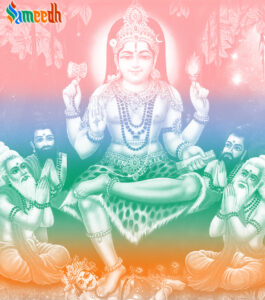Dakshinamurthy is indeed a form of Lord Shiva in Hinduism. Dakshinamurthy, also known as Jnana Dakshinamurthy, is a manifestation of Shiva as the supreme teacher of knowledge and wisdom. The name “Dakshinamurthy” is derived from two Sanskrit words: “Dakshina,” meaning south, and “Amurthy,” meaning formless. Therefore, Dakshinamurthy is often translated as “The Formless One Facing South.”

In this form of Shiv, he is depicted as a sage or yogi who imparts spiritual wisdom to his disciples through the eloquence of silence, gestures, and profound meditation. Dakshinamurthy is typically portrayed as a seated figure under a banyan tree, surrounded by sages and seekers eager to receive knowledge.
Dakshinamurthy is considered the ultimate teacher, imparting knowledge not only through words but also through silence and the profound state of meditation. He is regarded as the guru of all gurus, guiding seekers on the path of spiritual wisdom.
The serene and silent demeanor of Dakshinamurthy emphasizes the importance of inner contemplation and the direct experience of truth beyond words. The light of the flame held by Dakshinamurthy symbolizes the dispelling of ignorance and the illumination of true knowledge.
The iconography of Dakshinamurthy includes several symbolic elements:
- Meditative Posture: Dakshinamurthy is usually shown sitting in a yogic posture, reflecting deep meditation and inner tranquility. Dakshinamurthy is often associated with the practice of yoga and meditation.
- Four Arms: The four arms represent the four directions and symbolize Shiv‘s all-encompassing nature. His posture and mudras (hand gestures) suggest a state of deep meditation and inner tranquility.
- Gesture of Teaching (Chin Mudra): The right hand is often depicted in the chin mudra, a gesture that signifies the imparting of knowledge and wisdom.
- Attributes: Dakshinamurthy may hold a drum (damaru), symbolizing the rhythmic sound of creation, a flame (jyoti) representing the light of knowledge, a book (pustaka) symbolizing sacred texts, and sometimes a rosary (akshamala) indicating the cyclical nature of time.
Devotees and seekers worship Dakshinamurthy to seek spiritual guidance and understanding. The form emphasizes the importance of knowledge, meditation, and the teacher-student relationship on the path of spiritual realization. Dakshinamurthy is particularly revered by those pursuing the study of scriptures, philosophy, and meditation.